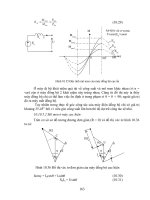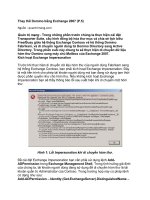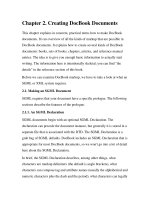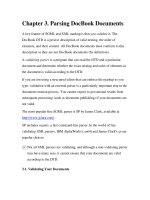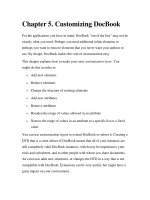Tài liệu DocBox the Definitive Guide-Chapter 2. Creating DocBook Documents pptx
Bạn đang xem bản rút gọn của tài liệu. Xem và tải ngay bản đầy đủ của tài liệu tại đây (126.22 KB, 64 trang )
Chapter 2. Creating DocBook Documents
This chapter explains in concrete, practical terms how to make DocBook
documents. It's an overview of all the kinds of markup that are possible in
DocBook documents. It explains how to create several kinds of DocBook
documents: books, sets of books, chapters, articles, and reference manual
entries. The idea is to give you enough basic information to actually start
writing. The information here is intentionally skeletal; you can find "the
details" in the reference section of this book.
Before we can examine DocBook markup, we have to take a look at what an
SGML or XML system requires.
2.1. Making an SGML Document
SGML requires that your document have a specific prologue. The following
sections describe the features of the prologue.
2.1.1. An SGML Declaration
SGML documents begin with an optional SGML Declaration. The
declaration can precede the document instance, but generally it is stored in a
separate file that is associated with the DTD. The SGML Declaration is a
grab bag of SGML defaults. DocBook includes an SGML Declaration that is
appropriate for most DocBook documents, so we won't go into a lot of detail
here about the SGML Declaration.
In brief, the SGML Declaration describes, among other things, what
characters are markup delimiters (the default is angle brackets), what
characters can compose tag and attribute names (usually the alphabetical and
numeric characters plus the dash and the period), what characters can legally
occur within your document, how long SGML "names" and "numbers" can
be, what sort of minimizations (abbreviation of markup) are allowed, and so
on. Changing the SGML Declaration is rarely necessary, and because many
tools only partially support changes to the declaration, changing it is best
avoided, if possible.
Wayne Wholer has written an excellent tutorial on the SGML Declaration; if
you're interested in more details, see is-
open.org/cover/wlw11.html.
2.1.2. A Document Type Declaration
All SGML documents must begin with a document type declaration. This
identifies the DTD that will be used by the document and what the root
element of the document will be. A typical doctype declaration for a
DocBook document looks like this:
<!DOCTYPE book PUBLIC "-//OASIS//DTD DocBook
V3.1//EN">
This declaration indicates that the root element, which is the first element in
the hierarchical structure of the document, will be <book> and that the
DTD used will be the one identified by the public identifier -
//OASIS//DTD DocBook V3.1//EN. See Section 2.3.1
" later in this
chapter.
2.1.3. An Internal Subset
It's also possible to provide additional declarations in a document by placing
them in the document type declaration:
<!DOCTYPE book PUBLIC "-//OASIS//DTD DocBook
V3.1//EN" [
<!ENTITY nwalsh "Norman Walsh">
<!ENTITY chap1 SYSTEM "chap1.sgm">
<!ENTITY chap2 SYSTEM "chap2.sgm">
]>
These declarations form what is known as the internal subset. The
declarations stored in the file referenced by the public or system identifier in
the DOCTYPE declaration is called the external subset and it is technically
optional. It is legal to put the DTD in the internal subset and to have no
external subset, but for a DTD as large as DocBook that wouldn't make
much sense.
The internal subset is parsed first and, if multiple declarations for an
entity occur, the first declaration is used. Declarations in the internal
subset override declarations in the external subset.
2.1.4. The Document (or Root) Element
Although comments and processing instructions may occur between the
document type declaration and the root element, the root element usually
immediately follows the document type declaration:
<!DOCTYPE book PUBLIC "-//OASIS//DTD DocBook
V3.1//EN" [
<!ENTITY nwalsh "Norman Walsh">
<!ENTITY chap1 SYSTEM "chap1.sgm">
<!ENTITY chap2 SYSTEM "chap2.sgm">
]>
<book>
&chap1;
&chap2;
</book>
You cannot place the root element of the document in an external entity.
2.1.5. Typing an SGML Document
If you are entering SGML using a text editor such as Emacs or vi, there are a
few things to keep in mind.[1]
Using a structured text editor designed for
SGML hides most of these issues.
• DocBook element and attribute names are not case-sensitive. There's
no difference between <Para> and <pArA>. Entity names are case-
sensitive, however.
If you are interested in future XML compatibility, input all element
and attribute names strictly in lowercase.
• If attribute values contain spaces or punctuation characters, you must
quote them. You are not required to quote attribute values if they
consist of a single word or number, although it is not wrong to do so.
When quoting attribute values, you can use either a straight single
quote ('), or a straight double quote ("). Don't use the "curly" quotes ("
and ") in your editing tool.
If you are interested in future XML compatibility, always quote all
attribute values.
• Several forms of markup minimization are allowed, including empty
tags. Instead of typing the entire end tag for an element, you can type
simply </>. For example:
• <para>
• This is <emphasis>important</>: never stick
the tines of a fork
• in an electrical outlet.
</para>
You can use this technique for any and every tag, but it will make
your documents very hard to understand and difficult to debug if you
introduce errors. It is best to use this technique only for inline
elements containing a short string of text.
Empty start tags are also possible, but may be even more confusing.
For the record, if you encounter an empty start tag, the SGML parser
uses the element that ended last:
<para>
This is <emphasis>important</>. So is
<>this</>.
</para>
Both "important" and "this" are emphasized.
If you are interested in future XML compatibility, don't use any of
these tricks.
• The null end tag (net) minimization feature allows constructions like
this:
• <para>
• This is <emphasis/important/: never stick the
tines of a fork
• in an electrical outlet.
</para>
If, instead of ending a start tag with >, you end it with a slash, then the
next occurrence of a slash ends the element.
If you are interested in future XML compatibility, don't use net tag
minimization either.
If you are willing to modify both the declaration and the DTD, even more
dramatic minimizations are possible, including completely omitted tags and
"shortcut" markup.
Removing Minimizations
Although we've made a point of reminding you about which of these
minimization features are not valid in XML, that's not really a sufficient
reason to avoid using them. (The fact that many of the minimization
features can lead to confusing, difficult-to-author documents might be.)
If you want to convert one of these documents to XML at some point in
the future, you can run it through a program like sgmlnorm, which will
remove all the minimizations and insert the correct, verbose markup. The
sgmlnorm program is part of the SP and Jade distributions
, which are on
the CD-ROM
.
2.2. Making an XML Document
In order to create DocBook documents in XML, you'll need an XML version
of DocBook. We've included one on the CD, but it hasn't been officially
adopted by the OASIS DocBook Technical Committee yet. If you're
interested in the technical details, Appendix B
, describes the specific
differences between SGML and XML versions of DocBook.
XML, like SGML, requires a specific prologue in your document. The
following sections describe the features of the XML prologue.
2.2.1. An XML Declaration
XML documents should begin with an XML declaration. Unlike the SGML
declaration, which is a grab bag of features, the XML declaration identifies a
few simple aspects of the document:
<?xml version="1.0" standalone="no"?>
Identifying the version of XML ensures that future changes to the XML
specification will not alter the semantics of this document. The standalone
declaration simply makes explicit the fact that this document cannot "stand
alone," and that it relies on an external DTD. The complete details of the
XML declaration are described in the XML specification
.
2.2.2. A Document Type Declaration
Strictly speaking, XML documents don't require a DTD. Realistically,
DocBook XML documents will have one.
The document type declaration identifies the DTD that will be used by the
document and what the root element of the document will be. A typical
doctype declaration for a DocBook document looks like this:
<?xml version='1.0'?>
<!DOCTYPE book PUBLIC "-//Norman Walsh//DTD DocBk
XML V3.1.4//EN"
"
This declaration indicates that the root element will be <book> and that the
DTD used will be the one indentified by the public identifier -//Norman
Walsh//DTD DocBk XML V3.1.4//EN. External declarations in
XML must include a system identifier (the public identifier is optional). In
this example, the DTD is stored on a web server.
System identifiers in XML must be URIs. Many systems may accept
filenames and interpret them locally as file: URLs, but it's always correct
to fully qualify them.
2.2.3. An Internal Subset
It's also possible to provide additional declarations in a document by placing
them in the document type declaration:
<?xml version='1.0'?>
<!DOCTYPE book PUBLIC "-//Norman Walsh//DTD DocBk
XML V3.1.4/EN"
" [
<!ENTITY nwalsh "Norman Walsh">
<!ENTITY chap1 SYSTEM "chap1.sgm">
<!ENTITY chap2 SYSTEM "chap2.sgm">
]>
These declarations form what is known as the internal subset. The
declarations stored in the file referenced by the public or system identifier in
the DOCTYPE declaration is called the external subset, which is technically
optional. It is legal to put the DTD in the internal subset and to have no
external subset, but for a DTD as large as DocBook, that would make very
little sense.
The internal subset is parsed first in XML and, if multiple declarations
for an entity occur, the first declaration is used. Declarations in the
internal subset override declarations in the external subset.
2.2.4. The Document (or Root) Element
Although comments and processing instructions may occur between the
document type declaration and the root element, the root element usually
immediately follows the document type declaration:
<?xml version='1.0'?>
<!DOCTYPE book PUBLIC "-//Norman Walsh//DTD DocBk
XML V3.1.4//EN"
" [
<!ENTITY nwalsh "Norman Walsh">
<!ENTITY chap1 SYSTEM "chap1.sgm">
<!ENTITY chap2 SYSTEM "chap2.sgm">
]>
<book> </book>
The important point is that the root element must be physically present
immediately after the document type declaration. You cannot place the root
element of the document in an external entity.
2.2.5. Typing an XML Document
If you are entering SGML using a text editor such as Emacs or vi, there are a
few things to keep in mind. Using a structured text editor designed for XML
hides most of these issues.
• In XML, all markup is case-sensitive. In the XML version of
DocBook, you must always type all element, attribute, and entity
names in lowercase.
• You are required to quote all attribute values in XML.
When quoting attribute values, you can use either a straight single
quote ('), or a straight double quote ("). Don't use the "curly" quotes ("
and ") in your editing tool.
• Empty elements in XML are marked with a distinctive syntax:
<xref/>.
• Processing instructions in XML begin and end with a question mark:
<?pitarget data?>.
• XML was designed to be served, received, and processed over the
Web. Two of its most important design principles are ease of
implementation and interoperability with both SGML and HTML.
The markup minimization features in SGML documents make it more
difficult to process, and harder to write a parser to interpret it; these
minimization features also run counter to the XML design principles
named above. As a result, XML does not support them.
Luckily, a good authoring environment can offer all of the features of
markup minimization without interfering with the interoperability of
documents. And because XML tools are easier to write, it's likely that
good, inexpensive XML authoring environments will be available
eventually.
2.2.6. XML and SGML Markup Considerations in This Book
Conceptually, almost everything in this book applies equally to SGML and
XML. But because DocBook V3.1 is an SGML DTD, we naturally tend to
use SGML conventions in our writing. If you're primarily interested in
XML, there are just a few small details to keep in mind.
• XML is case-sensitive, while the SGML version of DocBook is not.
In this book, we've chosen to present the element names using mixed
case (Book
, indexterm, XRef, and so on), but in the DocBook
XML DTD, all element, attribute, and entity names are strictly
lowercase.
• Empty element start tags in XML are marked with a distinctive
syntax: <xref/>. In SGML, the trailing slash is not present, so some
of our examples need slight revisions to be valid XML elements.
• Processing instructions in XML begin and end with a question mark:
<?pitarget data?>. In SGML, the trailing question mark is not
present, so some of our examples need slight revisions to be valid
XML elements.
• Generally we use public identifiers in examples, but whenever system
identifiers are used, don't forget that XML system identifiers must be
Uniform Resource Indicators (URIs), in which SGML system
identifiers are usually simple filenames.
For a more detailed discussion of DocBook and XML, see Appendix B
.
2.3. Public Identifiers, System Identifiers, and Catalog Files
When a DTD or other external file is referenced from a document, the
reference can be specified in three ways: using a public identifier, a system
identifier, or both. In XML, the system identifier is generally required and
the public identifier is optional. In SGML, neither is required, but at least
one must be present.[2]
A public identifier is a globally unique, abstract name, such as the following,
which is the official public identifier for DocBook V3.1:
-//OASIS//DTD DocBook V3.1//EN
The introduction of XML has added some small complications to system
identifiers. In SGML, a system identifier generally points to a single, local
version of a file using local system conventions. In XML, it must point with
a Uniform Resource Indicator (URI). The most common URI today is the
Uniform Resource Locator (URL), which is familiar to anyone who browses
the Web. URLs are a lot like SGML system identifiers, because they
generally point to a single version of a file on a particular machine. In the
future, Uniform Resource Names (URN), another form of URI, will allow
XML system identifiers to have the abstract characteristics of public
identifiers.
The following filename is an example of an SGML system identifier:
/usr/local/sgml/docbook/3.1/docbook.dtd
An equivalent XML system identifier might be:
file:///usr/local/sgml/docbook/3.1/docbook.dtd
The advantage of using the public identifier is that it makes your documents
more portable. For any system on which DocBook is installed, the public
identifier will resolve to the appropriate local version of the DTD (if public
identifiers can be resolved at all).
Public identifiers have two disadvantages:
• Because XML does not require them, and because system identifiers
are required, developing XML tools may not provide adequate support
for public identifiers. To work with these systems you must use
system identifiers.
• Public identifiers aren't magical. They're simply a method of
indirection. For them to work, there must be a resolution mechanism
for public identifiers. Luckily, several years ago, SGML Open (now
OASIS
) described a standard mechanism for mapping public
identifiers to system identifers using catalog files.
See OASIS Technical Resolution 9401:1997 (Amendment 2 to TR
9401).
2.3.1. Public Identifiers
An important characteristic of public identifiers is that they are globally
unique. Referring to a document with a public identifier should mean that
the identifier will resolve to the same actual document on any system even
though the location of that document on each system may vary. As a rule,
you should never reuse public identifiers, and a published revision should
have a new public identifier. Not following these rules defeats one purpose
of the public identifier.
A public identifier can be any string of upper- and lowercase letters, digits,
any of the following symbols: "'", "(", ")", "+", ",", "-", ".", "/", ":", "=", "?",
and white space, including line breaks.
2.3.1.1. Formal public identifiers
Most public identifiers conform to the ISO 8879 standard that defines formal
public identifiers. Formal public identifiers, frequently referred to as FPI,
have a prescribed format that can ensure uniqueness:[3]
prefix//owner-identifier//text-class text-
description//language//display-version
Here are descriptions of the identifiers in this string:
prefix
The prefix is either a "+" or a "-" Registered public identifiers
begin with "+"; unregistered identifiers begin with "-".
(ISO standards sometimes use a third form beginning with ISO and
the standard number, but this form is only available to ISO.)
The purpose of registration is to guarantee a unique owner-identifier.
There are few authorities with the power to issue registered public
identifiers, so in practice unregistered identifiers are more common.
The Graphics Communication Association
(GCA) can assign
registered public identifiers. They do this by issuing the applicant a
unique string and declaring the format of the owner identifier. For
example, the Davenport Group was issued the string "A00002" and
could have published DocBook using an FPI of the following form:
+//ISO/IEC 9070/RA::A00002//
Another way to use a registered public identifier is to use the format
reserved for internet domain names. For example, O'Reilly can issue
documents using an FPI of the following form:
+//IDN oreilly.com//
As of DocBook V3.1, the OASIS Technical Committee responsible
for DocBook has elected to use the unregistered owner identifier,
OASIS, thus its prefix is
-//OASIS//
owner-identifier
Identifies the person or organization that owns the identifier.
Registration guarantees a unique owner identifier. Short of
registration, some effort should be made to ensure that the owner
identifier is globally unique. A company name, for example, is a
reasonable choice as are Internet domain names. It's also not
uncommon to see the names of individuals used as the owner-
identifier, although clearly this may introduce collisions over time.
The owner-identifier for DocBook V3.1 is OASIS. Earlier versions
used the owner-identifier Davenport.
text-class
The text class identifies the kind of document that is associated with
this public identifier. Common text classes are
DOCUMENT
An SGML or XML document.
DTD
A DTD or part of a DTD.
ELEMENTS
A collection of element declarations.
ENTITIES
A collection of entity declarations.
NONSGML
Data that is not in SGML or XML.
DocBook is a DTD, thus its text class is DTD.
text-description
This field provides a description of the document. The text description
is free-form, but cannot include the string //.
The text description of DocBook is DocBook V3.1.
In the uncommon case of unavailable public texts (FPIs for
proprietary DTDs, for example), there are a few other options
available (technically in front of or in place of the text description),
but they're rarely used. [4]
language
Indicates the language in which the document is written. It is
recommended that the ISO standard two-letter language codes be used
if possible.
DocBook is an English-language DTD, thus its language is EN.
display-version
This field, which is not frequently used, distinguishes between public
texts that are the same except for the display device or system to
which they apply.
For example, the FPI for the ISO Latin 1 character set is:
-//ISO 8879-1986//ENTITIES Added Latin 1//EN
A reasonable FPI for an XML version of this character set is:
-//ISO 8879-1986//ENTITIES Added Latin
1//EN//XML
2.3.2. System Identifiers
System identifiers are usually filenames on the local system. In SGML,
there's no constraint on what they can be. Anything that your SGML
processing system recognizes is allowed. In XML, system identifiers must
be URIs (Uniform Resource Identifiers).
The use of URIs as system identifiers introduces the possibility that a system
identifier can be a URN. This allows the system identifier to benefit from the
same global uniqueness benefit as the public identifier. It seems likely that
XML system identifiers will eventually move in this direction.
2.3.3. Catalog Files
Catalog files are the standard mechanism for resolving public identifiers into
system identifiers. Some resolution mechanism is necessary because
DocBook refers to its component modules with public identifiers, and those
must be mapped to actual files on the system before any piece of software
can actually load them.
The catalog file format was defined in 1994 by SGML Open (now OASIS).
The formal specification is contained in OASIS Technical Resolution
9401:1997.
Informally, a catalog is a text file that contains a number of keyword/value
pairs. The most frequently used keywords are PUBLIC, SYSTEM,
SGMLDECL, DTDDECL, CATALOG, OVERRIDE, DELEGATE, and
DOCTYPE.
PUBLIC
The PUBLIC keyword maps public identifiers to system identifiers:
PUBLIC "-//OASIS//DTD DocBook V3.1//EN"
"docbook/3.1/docbook.dtd"
SYSTEM
The SYSTEM keyword maps system identifiers to system identifiers:
SYSTEM
"
"docbook/xml/1.3/db3xml.dtd"
SGMLDECL
The SGMLDECL keyword identifies the system identifier of the
SGML Declaration that should be used:
SGMLDECL "docbook/3.1/docbook.dcl"
DTDDECL
Like SGMLDECL, DTDDECL identifies the SGML Declaration that
should be used. DTDDECL associates a declaration with a particular
public identifier for a DTD:
DTDDECL "-//OASIS//DTD DocBook V3.1//EN"
"docbook/3.1/docbook.dcl"
Unfortunately, it is not supported by the free tools that are available.
The practical benefit of DTDDECL can usually be achieved, albeit in a
slightly cumbersome way, with multiple catalog files.
CATALOG
The CATALOG keyword allows one catalog to include the content of
another. This can make maintenance somewhat easier and allows a
system to directly use the catalog files included in DTD distributions.
For example, the DocBook distribution includes a catalog file. Rather
than copying each of the declarations in that catalog into your system
catalog, you can simply include the contents of the DocBook catalog:
CATALOG "docbook/3.1/catalog"
OVERRIDE
The OVERRIDE keyword indicates whether or not public identifiers
override system identifiers. If a given declaration includes both a
system identifer and a public identifier, most systems attempt to
process the document referenced by the system identifier, and
consequently ignore the public identifier. Specifying
OVERRIDE YES
in the catalog informs the processing system that resolution should be
attempted first with the public identifier.
DELEGATE
The DELEGATE keyword allows you to specify that some set of
public identifiers should be resolved by another catalog. Unlike the
CATALOG keyword, which loads the referenced catalog, DELEGATE
does nothing until an attempt is made to resolve a public identifier.
The DELEGATE entry specifies a partial public identifier and an
alternate catalog:
DELEGATE "-//OASIS" "/usr/sgml/oasis/catalog"
Partial public identifers are simply initial substring matches. Given the
preceding entry, if an attempt is made to match any public identifier
that begins with the string -//OASIS, the alternate catalog
/usr/sgml/oasis/catalog will be used instead of the current
catalog.
DOCTYPE
The DOCTYPE keyword allows you to specify a default system
identifier. If an SGML document begins with a DOCTYPE declaration
that specifies neither a public identifier nor a system identifier (or is
missing a DOCTYPE declaration altogether), the DOCTYPE
declaration may provide a default:
DOCTYPE BOOK
n:/share/sgml/docbook/3.1/docbook.dtd
A small fragment of an actual catalog file is shown in Example 2-1
.
Example 2-1. A Sample Catalog
Comments are delimited by pairs of double-
hyphens, (1)
as in SGML and XML comments.
OVERRIDE YES
(2)
SGMLDECL "n:/share/sgml/docbook/3.1/docbook.dcl"
(3)
DOCTYPE BOOK
n:/share/sgml/docbook/3.1/docbook.dtd (4)
PUBLIC "-//OASIS//DTD DocBook V3.1//EN"
(5)
n:/share/sgml/docbook/3.1/docbook.dtd
SYSTEM
"
(6)
n:/share/sgml/Norman_Walsh/db3xml/db3xml.dtd
(1)
Catalog files may also include comments.
(2)
This catalog specifies that public identifiers should be used in favor of
system identifiers, if both are present.
(3)
The default declaration specified by this catalog is the DocBook
declaration.
(4)
Given an explicit (or implied) SGML DOCTYPE of
<!DOCTYPE BOOK SYSTEM>
use n:/share/sgml/docbook/3.1/docbook.dtd as the
default system identifier. Note that this can only apply to SGML
documents because the DOCTYPE declaration above is not a valid
XML element.
(5)
Map the OASIS public identifer to the local copy of the DocBook
V3.1 DTD.
(6)
Map a system identifer for the XML version of DocBook to a local
version.
A few notes:
• It's not uncommon to have several catalog files. See below, Section
2.3.3.1".
• Like attributes on elements you can quote, the public identifier and
system identifier are surrounded by either single or double quotes.
• White space in the catalog file is generally irrelevant. You can use
spaces, tabs, or new lines between keywords and their arguments.
• When a relative system identifier is used, it is considered to be
relative to the location of the catalog file, not the document being
processed.
2.3.3.1. Locating catalog files
Catalog files go a long way towards making documents more portable by
introducing a level of indirection. A problem still remains, however: how
does a processor locate the appropriate catalog file(s)? OASIS outlines a
complete interchange packaging scheme, but for most applications the
answer is simply that the processor looks for a file called catalog or
CATALOG.
Some applications allow you to specify a list of directories that should be
examined for catalog files. Other tools allow you to specify the actual files.
Note that even if a list of directories or catalog files is provided, applications
may still load catalog files that occur in directories in which other
documents are found. For example, SP and Jade always load the catalog file
that occurs in the directory in which a DTD or document resides, even if that
directory is not on the catalog file list.
2.4. Physical Divisions: Breaking a Document into Physical Chunks
The rest of this chapter describes how you can break documents into logical
chunks, such as books, chapters, sections, and so on. Before we begin, and
while the subject of the internal subset is fresh in your mind, let's take a
quick look at how to break documents into separate physical chunks.
Actually, we've already told you how to do it. If you recall, in the preceding
sections we had declarations of the form:
<!ENTITY name SYSTEM "filename">
If you refer to the entity name in your document after this declaration, the
system will insert the contents of the file filename into your document at
that point. So, if you've got a book that consists of three chapters and two
appendixes, you might create a file called book.sgm, which looks like this:
<!DOCTYPE book PUBLIC "-//OASIS//DTD DocBook
V3.1//EN" [
<!ENTITY chap1 SYSTEM "chap1.sgm">
<!ENTITY chap2 SYSTEM "chap2.sgm">
<!ENTITY chap3 SYSTEM "chap3.sgm">
<!ENTITY appa SYSTEM "appa.sgm">
<!ENTITY appb SYSTEM "appb.sgm">
]>
<book><title>My First Book</title>
&chap1;
&chap2;
&chap3;
&appa;
&appb;
</book>
You can then write the chapters and appendixes conveniently in separate
files. Note that these files do not and must not have document type
declarations.
For example, Chapter 1 might begin like this:
<chapter id="ch1"><title>My First Chapter</title>
<para>My first paragraph.</para>
But it should not begin with its own document type declaration:
<!DOCTYPE chapter PUBLIC "-//OASIS//DTD DocBook
V3.1//EN">
<chapter id="ch1"><title>My First Chapter</title>
<para>My first paragraph.</para>
2.5. Logical Divisions: The Categories of Elements in DocBook
DocBook elements can be divided broadly into these categories:
Sets
Books
Divisions, which divide books into parts
Components, which divide books or divisions into chapters
